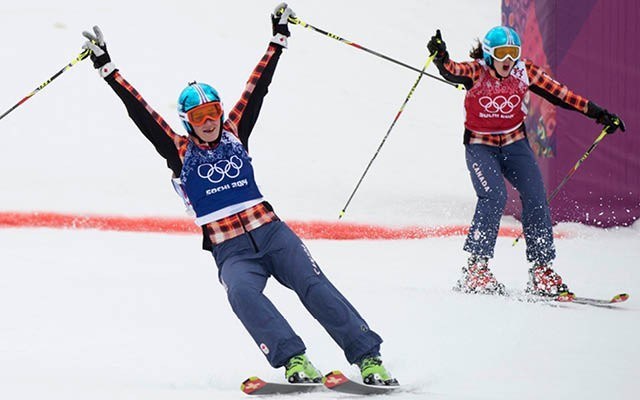As someone whose glory days as an athlete peaked with the captaincy of a bush league Saskatchewan minor hockey team in 2006, I’ve always found myself in awe of the raw talent that emanates from Whistler.
I realized it the first time I awkwardly strapped on a pair of skis and began my first descent down Whistler Mountain, shaky but nurturing a burgeoning confidence in my abilities—until a single-file row of four-year-olds ripped past me in perfect formation, dancing some sort of smooth, synchronized number behind a gleeful, carefree instructor.
Whistler kids are just built differently, man.
Take ski-cross racer Marielle Thompson, Olympic gold medallist in Sochi in 2014.
When she crashed in Switzerland in October 2017, rupturing her ACL just a few short months before the 2018 Olympics, many assumed her chances of competing at the Games were dashed.
But after an innovative surgery to repair the ACL, it was right back to the grind.
“I did do a lot of work; it was pretty well every single day from October to February, when I went to Korea,” she told me in an interview last year.
Thompson lined up with very little preparation—and immediately won the Olympic time trial.
“[That] was honestly a big takeaway—knowing that I can still be the fastest despite having basically no training or racing,” she said.
In preparation for that call, I watched some videos of Thompson training at the Whistler Athletes’ Centre. I think I ruptured my own ACL through my computer screen.
The typical recovery time for an ACL tear is six to nine months. Thompson was back and competing at the highest level of her sport in just over three.
For that same story, I spoke with halfpipe skier Simon d’Artois and luger Reid Watts—and that was when I realized the sheer concentration of top-level talent that just like, hangs out at the Whistler Athletes’ Centre every day.
“I’m in touch with them a little bit, but of course, we’re all different sports—but it’s kinda the same journey, right?” Watts said of his fellow Olympians.
As for what’s in the Whistler water that cultivates such a concentration of high-end talent, “it’s the best place in the world to call home … beautiful, super conducive to high-performance sport, and even going through high school it was incredibly accommodating for me,” Watts said.
“It was a great spot to grow up and start an athletic career.”
There are 215 Canadian athletes on the 2022 Beijing Olympic Winter Games roster ahead of Feb. 4’s Opening Ceremony.
Of those, six list Whistler as their hometown: Marielle and Broderick Thompson, Natalie Corless, Reid Watts, Simon d’Artois and Sofiane Gagnon.
This doesn’t take into account the other 2022 Olympians who live here, or otherwise have a local connection: people like Teal Harle, Darcy and Cassie Sharpe, Jack Crawford, Brodie Seger, Jasmine Baird and Derek Livingston.
And not to mention Pemberton’s Trinity Ellis; Benita Peiffer, an alternate for the biathlon team; Veronica Ravenna, a Whistler resident competing for her home country of Argentina; or Mollie Jepsen, and other Paralympians gearing up for their own Games in Beijing beginning March 4.
(There are no doubt more, and I have to add a line here apologizing for the local connections I’ve missed—as you can tell, the Whistler factor is much harder to track than it appears on the surface.)
For the sake of the following math exercise, let’s stick to the six “official” Whistlerites.
In 2022, only five cities are sending more: Calgary has 21 (population 1.33 million); Montreal has 11 (population 1.78 million); Toronto and Ottawa both have nine (populations 2.9 million and 995,000, respectively); and Sherbrooke, Que., has seven (population 167,162).
Bear with me here. I’m better with words than numbers.
But Whistler’s six Olympians and roughly 14,000 permanent residents translate to about one Olympian per 2,300 residents.
Calgary residents have to share an Olympian between every 63,619 people. In Montreal, it’s one Olympian for every 162,000 residents, Toronto, 322,000 or so.
The closest to Whistler on a per-capita basis is Sherbooke, which has one Olympian for every 23,880 residents.
Again, this is only counting the six Olympians who officially list Whistler as their hometown—the actual impact of our little resort on the world’s biggest sporting stage is significantly greater.
Whistler is technically sending more athletes to the Games this year than my entire home province of Saskatchewan (six athletes from a population of 1.174 million—but let’s be honest, this one’s no surprise… it’s really flat there).
It would be easy, and justified, to dump on this year’s Olympics for many things: China’s well-documented human rights abuses and the corruption of the International Olympic Committee chief among them.
But I’ll leave that to the other columnists.
This piece is for the athletes, coaches and trainers who make Whistler shine on the biggest stage of them all.
It’s for those who work and train tirelessly in the sports they love, who inspire the rest of us to push for greatness in our own little areas of existence.
Hell, it’s even for all the other athletes born and bred in Whistler, kicking ass at competitions big and small, near and far—to list you all would require more space than this column affords, but following your careers is one of the best parts of being a Whistlerite.
Pique has some fun stuff planned for the next two weeks of the Games, including a daily blog and behind-the-scenes photos and insights. You can find it all (along with feature profiles of most of our local athletes) at piquenewsmagazine.com/2022-winter-olympics.
The next two weeks are primed for both triumph and heartbreak, personal bests and less than was hoped for—but whether or not our Whistler athletes find themselves on the podium this year, they’ve already done us proud.




